Maramu
Sailboat specifications
The Maramu is a 45’4” (13.8m) cruising sailboat designed by Henri Amel (France) and Jacques Carteau (France). She was built between 1978 and 1989 by Amel (France) with 288 hulls completed.
Maramu's main features
- Model
- Maramu
- Hull type
- Monohull
- Category
- Offshore cruising sailboat
- Sailboat builder
- Sailboat designer
- Country
- France
- Construction
- Hull and deck: GRP (glass reinforced polyester)
- Number of hulls built
- 288
- First built hull
- 1978
- Last built hull
- 1989
- Appendages
- Keel : L-shaped keel (with bulb)
- Helm
- Single helm wheel
- Rudder
- Single rudder on skeg
- Unsinkable
- No
- Trailerable
- No
- Former French navigation category
- 1
- Standard public price ex. VAT (indicative only)
- N/A €
Maramu's main dimensions
- Hull length
- 45’ 4”13.8 m
- Waterline length
- 35’ 10”10.9 m
- Beam (width)
- 13’ 1”4 m
- Draft
- 6’ 2”1.9 m
- Mast height from DWL
- 55’ 10”17 m
- Light displacement (MLC)
- 30865 lb14000 kg
- Ballast weight
- 8818 lb4000 kg
Maramu's rig and sails
- Upwind sail area
- 1055 ft²98 m²
- Downwind sail area
- 1485 ft²138 m²
- Mainsail area
- 291 ft²27 m²
- Mizzen sail area
- 161 ft²15 m²
- Genoa area
- 603 ft²56 m²
- Symmetric spinnaker area
- 1033 ft²96 m²
- IiFore triangle height (from mast foot to fore stay top attachment)
- 46’ 5”14.14 m
- JiFore triangle base (from mast foot to bottom of forestay)
- 15’ 1”4.59 m
- PiMainsail hoist measurement (from tack to head)
- 41’ 5”12.62 m
- EiMainsail foot measurement (from tack to clew)
- 13’ 6”4.13 m
- Rigging type
- Ketch Marconi (in-mast furling mainsail) masthead
- Mast configuration
- Deck stepped mast
- Rotating spars
- No
- Number of levels of spreaders
- 2
- Spreaders angle
- 0 °
- Spars construction
- Aluminum spars
- Standing rigging
- 1x19 strand wire
Maramu's performances
- Upwind sail area to displacementiThe ratio sail area to displacement is obtained by dividing the sail area by the boat's displaced volume to the power two-thirds.
The ratio sail area to displacement can be used to compare the relative sail plan of different sailboats no matter what their size.
Upwind: under 18 the ratio indicates a cruise oriented sailboat with limited performances especially in light wind, while over 25 it indicates a fast sailboat. - 182 ft²/T16.87 m²/T
- Downwind sail area to displacementiThe ratio sail area to displacement is obtained by dividing the sail area by the boat's displaced volume to the power two-thirds.
The ratio sail area to displacement can be used to compare the relative sail plan of different sailboats no matter what their size. - 256 ft²/T23.76 m²/T
- Displacement-length ratio (DLR)iThe Displacement Length Ratio (DLR) is a figure that points out the boat's weight compared to its waterline length. The DLR is obtained by dividing the boat's displacement in tons by the cube of one one-hundredth of the waterline length (in feet).
The DLR can be used to compare the relative mass of different sailboats no matter what their length:
a DLR less than 180 is indicative of a really light sailboat (race boat made for planning), while a DLR greater than 300 is indicative of a heavy cruising sailboat. - 306
- Ballast ratioiThe Ballast ratio is an indicator of stability; it is obtained by dividing the boat's displacement by the mass of the ballast. Since the stability depends also of the hull shapes and the position of the center of gravity, only the boats with similar ballast arrangements and hull shapes should be compared.
The higher the ballast ratio is, the greater is the stability. - 29 %
- Critical hull speediAs a ship moves in the water, it creates standing waves that oppose its movement. This effect increases dramatically the resistance when the boat reaches a speed-length ratio (speed-length ratio is the ratio between the speed in knots and the square root of the waterline length in feet) of about 1.2 (corresponding to a Froude Number of 0.35) . This very sharp rise in resistance, between speed-length ratio of 1.2 to 1.5, is insurmountable for heavy sailboats and so becomes an apparent barrier. This leads to the concept of "hull speed".
The hull speed is obtained by multiplying the square root of the waterline length (in feet) by 1.34. - 8.01 knots
Maramu's auxiliary engine
- Engine(s)
- 1 inboard engine
- Engine(s) power
- 60 HP
- Fuel type
- Diesel
- Fuel tank capacity
- 126.8 gal480 liters
Maramu's accommodations and layout
- Cockpit
- Center cockpit
- Cabin(s)
- 2
- Berth(s) (min./max.)
- 6 / 7
- Head(s)
- 2
- Freshwater tank capacity
- 285.3 gal1080 liters
- Maximum headroom
- 6’ 5”1.95 m

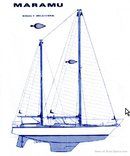


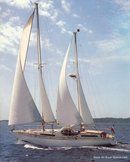
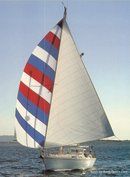


Amel Maramu interior and accommodations - - 7/10
Picture extracted from the commercial documentation © Amel
Picture extracted from the commercial documentation © Amel
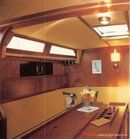

Amel Maramu interior and accommodations - - 8/10
Picture extracted from the commercial documentation © Amel
Picture extracted from the commercial documentation © Amel
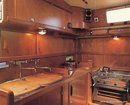

Amel Maramu interior and accommodations - - 9/10
Picture extracted from the commercial documentation © Amel
Picture extracted from the commercial documentation © Amel


Amel Maramu interior and accommodations - - 10/10
Picture extracted from the commercial documentation © Amel
Picture extracted from the commercial documentation © Amel
Similar sailboats that may interest you:
Sailboats
First built hull
Hull length
1993
44’13.4 m
2007
44’ 6”13.57 m
1989
45’ 4”13.8 m
1988
52’ 6”16 m
1991
40’ 1”12.22 m
1991
43’ 5”13.22 m
1995
48’ 6”14.78 m
2011
43’ 6”13.25 m
1996
41’ 10”12.75 m
2000
52’ 6”16 m
2017
50’ 11”15.51 m
1984
42’ 4”12.9 m
1985
49’ 11”15.22 m
2018
48’14.63 m
1979
39’ 2”11.95 m